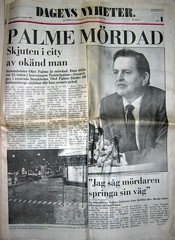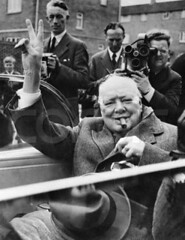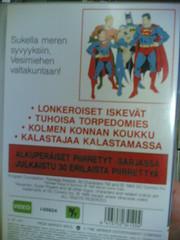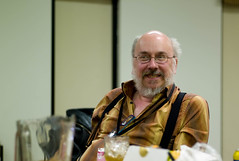Thursday, March 26, 2009
Once Were Consumers
The theme spreading across the book is the way we tackle climate change. According to Neuvonen and Mokka, most of us wish that there will be a day when we will be told by The Leader what not to do and until then most of us continue flying and buying in the current accelerating speed - fully aware of its consequences. The reaction is the same as a child who covers his eyes and ears to avoid the bad news. According to the book we need to recognise our role in change for as long as we wait for our elected leaders to make that switch, we are somewhat doomed. Over the last few years politics has actually taken its lessons from consumerism - politics is more a service industry answering people´s wishes than about ethics, ambitions or doing the right and responsible thing. This is very clear in political rhetorics of today. Therefore that SUV will only be banned when the big middle class takes another turn in its consumption. The book is a rare but realistic call for individual responsibility together with others.
The scenarios see control rising as we fight for limited resources. Control is also one of the ways to make people change. Rather than listening to our neighbours through the wall, in 15 years we can follow the ecological footprint of our neighbours from a public record Wastebook. In a world of less, we will surely make sure that our neighbours will not be free riding the system. This has been happening already in some countries in smaller scale for instance by people reporting their neighbours to the authorities when they do not recycle their trash.
The book claims that have moved from Social Democratic I Need Politics to more Centre Liberal I Want Politics. We are seeing the emergence of I Can Politics but the true change happens when we make a shift to We Can. When the media, corporations and governments take a bigger role in showing us the interconnectedness, we move from rights and responsibilities to virtues and pursuing truer happiness through responsible action and more meaningful human relationships. It moves discussion from what I want to what we can do.
This liberation from consumerism and move towards citizenship is quite inspiring and Case Obama is a good example of how it functions as a rhetorical tool. But I end up thinking, after reading the book, what happens when the resources really start running out. What are the arguments for building trust? The book paints a relatively beautiful picture of collective action but I feel it slightly - maybe for the argument´s sake - downplays the conflict and difference of opinion on the tools to make the switch. Politics is about deciding on those alternatives. It is not a question of The Good vs. The Bad but different strategies maybe even towards a shared goal. Does the urgency make our political system more responsible or more vicious What kind of leaders to we get, wish and deserve?
Olimme kuluttajia makes a convincing case that we have no alternative but to change. But I recognise I am already somewhat in the inner circle of this stuff. Reading it makes me reorient my professional focus to enhancing those positive developments and using my writing skills to formulate those attractive arguments to convince ever bigger parts of the population. This requires reaching over the aisle and bringing the engineer, marketeer and politician to the same table to build that map of interconnectedness. And yes, this is terribly exciting.
Monday, March 23, 2009
Who Wants To Be A Journalist
I have been mongering (is that a word) about the state of media education for ages. I feel that it more than often focuses on protecting young people from "the media", treats children and teenagers and imbeciles, forgets the role of amateurs in creating media content and forgets notions of critical reading. Good description of the current debate here. For all this, it was great to visit Piste and see that someone knows how to do it.
Sanoma Corporation has build a sort of a mini-Helsinki into the basement of its headquarters. The participants are divided to teams with some of them working for the quality daily Helsingin Sanomat and some for the tabloid Ilta-Sanomat. They all get mobiles, maps and guidance from an editor. All teams working on the same story and in the end they need to decide within their team on the angle of the story, on the headline and the photo.
Piste emphasises the key things in journalism:
- that good journalism requires dedication, persistence and investigation. You need to keep calling people, checking information given to you and making sure that you make good notes.
- it shows the essence of team work and clear division of tasks.
- it strengthens understanding that journalism is very much also about choices in terms of angle. That even if you have the same information, the story is different in Ilta-Sanomat and Helsingin Sanomat. Piste also demonstrates well how different the story seems with a different headline.
The great thing is also that the groups are led by real journalists who can through their own work show what all these issues mean in real life. I am sure this makes the visiting teenagers listen much more carefully. Our guide for instance was telling how you need to constantly make choices for instance around the school shootings on when to publish the name of the shooter or a certain photo. She also shed some light on the collaboration with the police and fire department.
I would be surprised if someone after Piste would not want to become a journalist. Piste demonstrates superbly how fascinating the job really is and how top quality media education really is done.
Friday, March 20, 2009
StrangerFestival Is About This
So, my former colleagues had put a clip from the StrangerFestival DVD online. I actually like how in this interview the background thinking of the project comes across.
And yes, someone should have told me to control those hands while I speak....I know, I know.
You can order your own copy of the DVD with this interview and much more from stranger (a) eurocult.org.
Wednesday, March 18, 2009
Nordic
I said first in the discussion that I would see the Nordic countries rather as a natural area of collaboration rather as an identity with historic routes. The ethnic-cultural-historical argument for the Nordic countries easily stands in the way of true equality and integration. The links are obvious to those Europeans who claim that we share the same values and a history.
I realised towards the end of the seminar that my idea of the Nordic region was something special and I feel parts of it can be explained through the Finnish language. I realise that I have grown up with an idea of the Nordic region as something where peace and justice prevail. This is something I picked up from school, not that much which country oppressed which Nordic country at which time and who really had the vikings.
I was brought up with the idea that the Nordic identity and aspiration can be explained through actions of people like Anna Lindh, Olof Palme, Martti Ahtisaari or Hans Blix. That Finland was on its way to being Nordic. That Nordic means also peculiar people who do not fit to all conventions and who dare to touch our sensitivities like Tove Jansson, Lars von Trier or Ingmar Bergman. That Nobel Peace Prize illustrates Nordic actions by Nordic and non-Nordic people. That being Nordic means believing in the human being, having a clear sense of ethics, trusting your neighbours (passport-free border-crossing for ages) and working for the benefit of mankind. That here in the North we give from our own when we have enough. That Nordic is something we need to work for - hard. And more often than we would like to admit, we we fall short in living up to those noble ideals. That Nordic is not a state of being, it is a responsibility for action. And that of course we should not claim to own this package of ideals but that the combination of them makes our life up in these circumstances worthwhile.
I wonder if this articulation of the Nordic identity could also function as a tool for integration and inclusion. It may sound slightly naive but it gives me a sense of direction and a reason for optimism. In term of integration we wound need recognise those beautiful ideas, make concrete the individual and societal work needed to make our way towards them and be honest about the shortcomings in terms of greed, protectionism and selfishness. Of this we have a tremendous amount of examples from the last 20 years.
That we would consciously shift our focus to what we can become at our best and to our personal responsibility rather than obsessing over a shared past. The Nordic Dream seen here would be very different from the European or American one.
Monday, March 16, 2009
Public Service
Entertainment has been one of the issues on the battlefield - whether public service broadcasters should do entertainment or leave it to the commercial competitors. Watching Sweden´s SVT´s work on the Eurovision Song Contest (they call it Melody Festival) shows how an innovative public service broadcaster can turn European cooperation amongst public service broadcasters into a national megaprojects reinvigorating areas by taking the semifinals to different parts of the country. It is entertainment but entertainments with a special value. Corny, camp but brilliant. In Sweden the national finale is the main thing, not how the Swedish entry ranks in the European arena. I kind of like that.
Watching this programme and looking into the issue of commercial screens, I must conclude that I do support the idea of an independent expert body to control, set limits and open new areas for public service communications and press work. I feel this would make YLE stronger, release YLE from (unnecessary) parliamentary control and also serve the society and the license fee payers better. It might help us in really articulating in a clearer way what is actually the public service in public broadcasting. BBC says:Educate, Entertain and Inform - I would go more for something like Empower, Encourage and Represent (I wrote about this issue in this blog in September).
Thursday, March 12, 2009
Oops, Stockmann
Or - as Toby well points out - that is what they were supposed to do. In the picture at Stockmann the hand is turned the other way than Churchill´s - i.e. in the picture the palm faces the person showing the sign -, which translates in the UK, Australia, New Zealand and a number of other places as Up Yours or F--- You. I am just waiting to see the confused English couple on a holiday in Helsinki standing in front of the display.
Oops. Well, it´s not like they would be selling S/M-themed puzzles in the toy section or something. Oh sorry, that happened already.
Tuesday, March 10, 2009
Great DVD
Risks of Freelancing
Monday, March 09, 2009
Face The Music
Thursday, March 05, 2009
Random Quote of the Day
"Nothing beats Finnish men! I can say that we were just ice fishing yesterday that I love Finnish men who are too noble to beat you, when I should probably be hit, when foam comes from the corners of my mouth and I say that once again me alone here all blah-blah! I would hit someone like that! The women that Finnish men tolerate, would never be tolerated in France! I would never marry a Frenchman, I would rather shoot a bullet into my head. Or maybe I would marry but at least would not do any art there."
- Vesa Sirén, Helsingin Sanomat.
How is that for a statement?
Wednesday, March 04, 2009
Minorities in the Media
We've seen some increased visibility of black journalists and commentators throughout the 2008 campaign season -- and they may remain on the air throughout an Obama administration -- but we need to watch to make sure that they do not fade into the background again. But, if we follow your argument, even those figures who make it into the mainstream media are, at best, relaying critiques and discourses which originate within the black community and at worse, they are involved in a process of self-censorship which makes them an imperfect vehicle for those messages.
The paradox of race and media may be that black Americans have lost access to many of the institutions and practices which sustained them during an era of segregation without achieving the benefits promised by a more "integrated" media environment. And that makes this a moment of risk -- as well as opportunity -- for minority Americans.
I suspect we are over-stating the problem in some ways. There are certainly some serious constraints on minority participation in cyberspace but a world of networked publics also does offer some opportunities for younger African-Americans to deliberate together and form opinion, which we need to explore more fully here."
In the quote above, MIT Professor Henry Jenkins brings together the two issues that I am focusing on at the moment: future of media and diversity. Jenkins upholds his reputation as a critical, academic but enthusiastic researcher. In his blog, Jenkins is currently engaged in a debate on the future of African Americans communities online with Dayna Cunningham, the Executive Director of the Community Innovators Lab at MIT. In her first post, Cunningham described how the black voice is disappearing from the media sphere:
"However, I would argue that today, black politics has largely been reduced to the electoral and legislative spheres; African American media too often promote black celebrity and individual advancement, and along with much of the black civic infrastructure, rarely focus on freedom discourse as a means of exploring strategies for collective political action and accountability to black interests. Perhaps only the Church has survived as an independent space for black voice--and even the Church is sometimes compromised by "prosperity gospel" preachers who have little time for freedom discourse."
Jenkins answers well to the concerns expressed by Cunningham and acknowledges the risks posed by the fact that online it is very difficult to contain ideas in a certain context. There are still two chapters to follow in their discussion, I recommend staying alert.
Monday, March 02, 2009
This Is The World That We Live In
(Thanks for the link for this video, M)
















